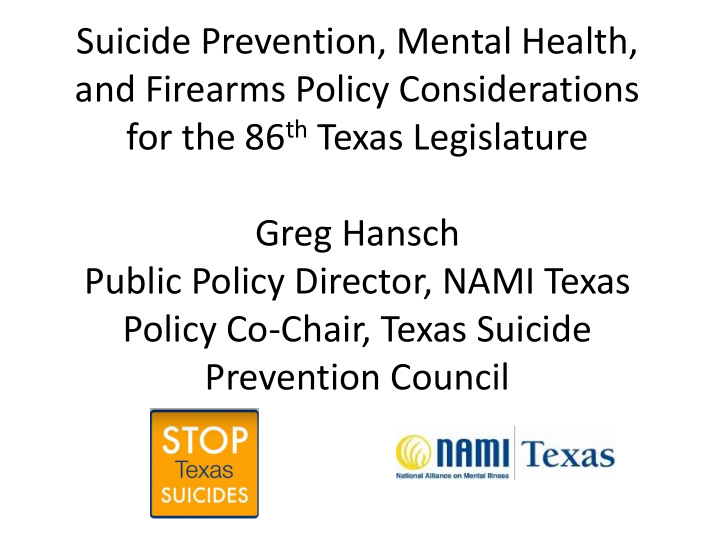



Suicide Prevention, Mental Health, and Firearms Policy Considerations for the 86 th Texas Legislature Greg Hansch Public Policy Director, NAMI Texas Policy Co-Chair, Texas Suicide Prevention Council
Background on Suicide in TX • Twelve percent of Texas high school students attempted suicide in 2017 (national average is seven percent) • From 1999 to 2016, Texas saw a 19% increase in the number of suicides • One person dies by suicide every 3 hours in TX • Suicide cost is over $1,000,000 per person, factoring in medical costs and lost productivity • More than just mental illness
Life expectancy in the U.S.
What’s driving decline in life expectancy?
Firearms and Suicide • 60% of gun deaths are suicides • 50% of suicides are gun deaths • Most people who attempt suicide do not die — unless they use a gun. • Attempts often impulsive: In 71% of suicide attempts that do not result in death, the person attempting made that decision within the hour. • Suicide attempts with a gun rarely afford a second chance
Priority Area: Education & School Suicide Prevention 1. Share information with policy leaders on the need for funding for Suicide Safer Schools and other best practice based school suicide prevention programs 2. Strengthen requirements and reporting for teachers and educator training for suicide prevention.
Priority Area: Training for Health & Mental Health Professionals 3. Encourage support for suicide prevention training for health and mental health professionals
Priority Area: Access to Lethal Means 4. Encourage support for a safe storage outreach campaign for lethal means which contribute to death by suicide for high risk individuals 5. Share information on the life saving benefits and other states’ experience with Extreme Risk Protective Orders for suicide prevention
What about Emergency Detention? • Under Chapter 573 of the Texas Health and Safety Code, police may take a person into custody without a warrant if there is belief that the person has a mental illness and because of that mental illness there is substantial risk of harm. • Police may immediately seize any firearm found in possession of the person. (must comply with requirements of Code of Criminal Procedure 18.191)
DISPOSITION OF FIREARM SEIZED FROM PERSONS UNDER EMERGENCY DETENTION • Person must be provided with receipt and procedure for return • Law enforcement agency must contact court of commitment jurisdiction to request disposition of case • Court must notify law enforcement agency if person was released or committed • If released, law enforcement must verify if person can legally possess firearm and if person can, must notify person of this
What about Involuntary Mental Health Commitment? • If person was order to receive inpatient mental health services, law enforcement agency must notify person that they’re prohibited from purchasing firearm, may petition the court for relief, and may have firearm disposed of • A person can be order to participate in inpatient services if: mental illness, likelihood of serious harm to self or other or substantial stress or deterioration
Involuntary Mental Health Commitment (continued) • State law requires district and county clerks to report information on prohibiting mental health adjudications and commitments to the Texas Criminal Justice Information System (CJIS) maintained by the Texas Department of Public Safety (DPS).
Considerations re: Emergency detention and Involuntary Commitment • Emergency detention alone does not address person’s access to firearms. • Involuntary commitment is highly restrictive • The appropriate criteria for involuntary commitment involves much broader considerations than access to firearms. • Shortage of beds means involuntary commitment is not always an option • Vast majority of people with mental illness are not violent • More than just mental health
Recommend
More recommend